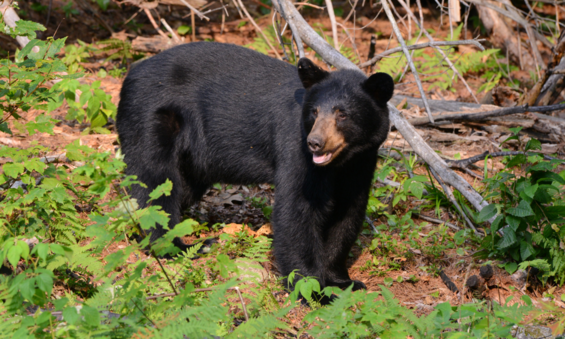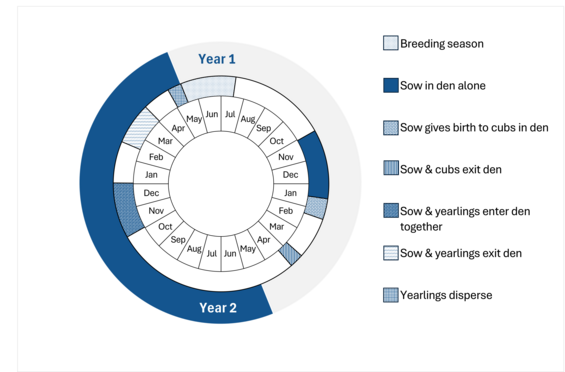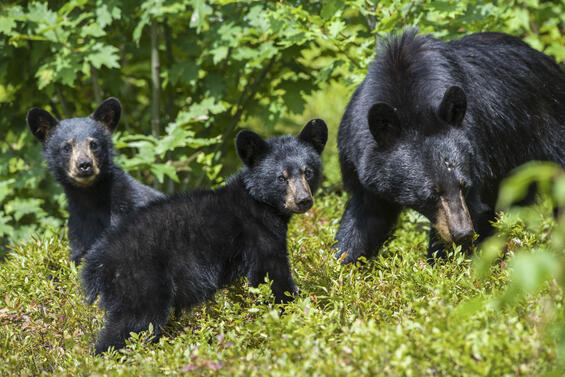- Scientific name: Ursus americanus
- Species of Greatest Conservation Need (MA State Wildlife Action Plan)
Description

Black bear (Ursus americanus)
Black bears are stocky and large-bodied with sturdy legs, flat, five-clawed feet, and coarse, shaggy fur. Black bears have small eyes, small, rounded ears, and a short tail. Although they may be brown or cinnamon-colored in open western habitats, almost all black bears in eastern deciduous forest are entirely black except for a brown muzzle and occasionally a white chest patch. Black bears range from 58–272 kg (130–600 lb) for adult males and 45–181 kg (100–400 lb) for adult females. Body length ranges from 1–2 m (3–6 ft).
Life cycle and behavior
Bears are omnivores. In spring, bears feed on lush, green emerging plants and are often seen in wetlands. In summer, they take advantage of ripening berries and can commonly be found in thick regenerating forest stands where berries are found. Ripened corn and stands of oak, beech, and hickory trees are favored foods in the fall. Bears also feed on grubs and insects, dead animals, and occasionally young deer. Bears will visit bird feeders, orchards, and beehives. Black bears have good eyesight and hearing and have an extraordinary sense of smell. They are excellent climbers and use trees to rest, escape threats, and protect their young.
Black bears mate between mid-May and mid-July (peaking in June). Depending on food availability and snow cover, bears will den between mid-November and early December and exit between early March and mid-April. Bears will den in brush piles, under fallen trees or jumbles of rocks, or in mountain laurel thickets. A litter of usually 2 or 3 cubs is born in the den in late January and they remain with the sow (adult female) for about 17 months.

This graphic represents the peak timing of life events for black bear in Massachusetts. Variation may occur across individuals and their range.
Population status
There are at least 4,500 black bears in Massachusetts with the population increasing up to 8% annually and expanding eastward.

Massachusetts towns with black bear harvest reports. 1970-2024. Based on MassWildlife records.

Massachusetts towns with black bear sightings and nuisance reports. 2015-winter 2025. Based on MassWildlife records.
Distribution and abundance
Historically, black bears could be found across mainland Massachusetts. Yet the population was nearly extirpated from the state in the 1800s due to land conversion from forest to agricultural fields and the unregulated killing of bears. Thanks to land protection and hunting regulations, black bears are once again common in western and central Massachusetts. They are becoming increasingly common in northeastern Massachusetts, with young males and some breeding females living in northeastern Massachusetts communities along Route 495 west of Route 3. Occasional young bears and wandering males occur in extremely northeastern, east-central, and southeastern Massachusetts.
Habitat
Black bears are forest animals. However, they have the ability to exploit a wide array of physiographic and vegetative associations. These may vary in climate, soils, and topography, which consequently affect the quantity, quality, and availability of food. These factors are primary determinants of black bear home range size, movements, and habitat use. Suitable black bear habitat is characterized by mature forest interspersed with small openings and tracts of early successional forest. Eastern deciduous forests, with their abundance and variety of foods, including acorns and other nut crops, yield the greatest black bear growth rates. In Massachusetts, wetlands are important to black bears in spring and summer, early successional and berry-producing areas in summer, and hardwood ridges in autumn.
Healthy habitats are vital for supporting native wildlife and plants. Explore habitats and learn about conservation and restoration in Massachusetts.

Threats
Although the black bear is the least threatened of the eight bear species and is stable or increasing in most of its range, it faces both short-term and long-term threats to its survival. Habitat fragmentation poses a serious risk to species (such as the black bear) with large home ranges and a sexually selected dispersal pattern. The consequent introgression of these large carnivores into human-dominated landscapes poses substantial ecological and conservation challenges. Alterations to bear habitat may degrade or modify the food biomass available to bears and coincidentally induce changes in their tolerance to humans, and that of humans to bears. Alterations to landscape mosaics, disruption of climatic cycles, rises in pollutant levels, draining of wetlands and waterways, and the proliferation of anthropogenic food sources will all affect the ability of the landscape to sustain black bears.
Conservation
Black bear research has been conducted in Massachusetts for over 4 decades. As of 2025, around 40 female bears have radio tracking collars to collect essential information about sow survival, causes of mortality, reproduction rates, and cub survival. About half the collars have GPS units that track bear movement and habitat use which has been used to provide data to Massachusetts Department of Transportation (DOT) to improve habitat connectivity and minimize road impacts on bears and other wildlife. Additional methods to estimate black bear density and population size is desired.
Black bears are big game mammals for which regulated hunting seasons and a management program have been established. Public education is essential to preventing human-bear conflict and increasing public acceptance of bears living in close proximity to humans.
References
Fuller, D.P. “Black bear population dynamics in western Massachusetts.” M.S. thesis, University of Massachusetts, Amherst, (1993): 136pp.
Pelton, M.R. “Black bear." Pages 547-555 in G.A. 2003. Feldhamer, B.C. Thompson, and J.A. Chapman (eds.). Wild Mammals of North America: Biology, Management, and Conservation. Baltimore, Maryland: Johns Hopkins University Press, 2003.
Servheen, C., S. Herrero, and B. Peyton (compilers). “Bears: status survey and conservation action plan.” International Union for the Conservation of Nature and Natural Resources, Gland, Switzerland, (1999): 309pp.
For more information on black bears from MassWildlife, visit mass.gov/bears.
Contact
| Date published: | May 1, 2025 |
|---|